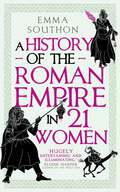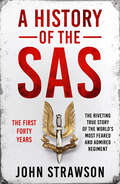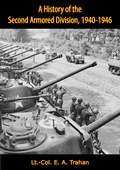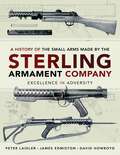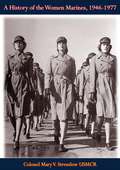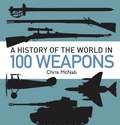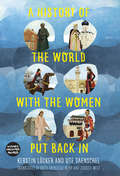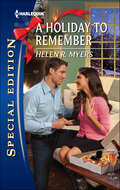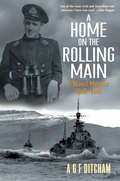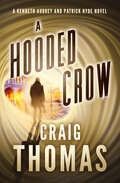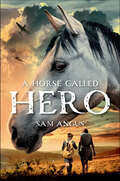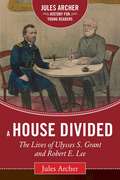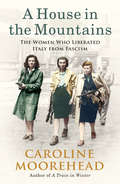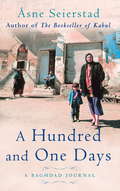- Table View
- List View
A History of the Roman Empire in 21 Women
by Emma SouthonRome as you&’ve never seen it before – brazenly unconventional, badly behaved and ever so feminine. &‘Hugely entertaining and illuminating&’ —Elodie Harper, author of The Wolf Den A WATERSTONES BEST HISTORY BOOK OF 2023 Here&’s how the history of the Roman Empire usually goes… We kick off with Romulus murdering his brother, go on to Brutus overthrowing Tarquin, bounce through an appallingly tedious list of battles and generals and consuls, before emerging into the political stab-fest of the late Republic. After &‘Et tu, Brute?&’, it runs through all the emperors, occasionally nodding to a wife or mother to show how bad things get when women won&’t do as they&’re told, until Constantine invents Christianity only for Attila the Hun to come and ruin everything. Let&’s tear up this script. The history of Rome and its empire is so much more than these &‘Important Things&’. In this alternative history, Emma Southon tells another story about the Romans, one that lives through Vestal Virgins and sex workers, business owners and poets, empresses and saints. Discover how entrepreneurial sex worker Hispala Faecenia uncovered a conspiracy of treason, human sacrifice and Bacchic orgies so wild they would make Donna Tartt blush, becoming one of Rome&’s unlikeliest heroes. Book yourself a table the House of Julia Felix and get to know Pompeii&’s savviest businesswoman and restauranteur. Indulge in an array of locally sourced delicacies as you take in the wonderful view of Mount Vesuvius… what could possibly go wrong? Join the inimitable Septimia Zenobia, who – after watching a series of incompetent, psychopathic and incompetently psychopathic emperors almost destroy the Empire – did what any of us would do. She declared herself Empress, took over half the Roman Empire and ran it herself.
A History of the SAS: The First Forty Years
by John Strawson“Who Dares Wins”. The world’s most legendary special forces unit - and a history of action you will barely believe. This is the extraordinary, secretive story of how the SAS evolved from an unconventional handful of soldiers, operating behind enemy lines in North Africa in 1941, into the world’s most disciplined and respected professionals, up to their daring and dangerous exploits in the Iranian Embassy siege and the Falkland Islands. We see them during the latter years of the Second World War, in the numerous post-war security campaigns in the Middle and Far East, and in the difficult circumstances of urban terrorism. Above all, we see how the regiment’s founder David Stirling’s emphasis on The Man has not changed at all. Here indeed are men who dare to excel - and in General Strawson they have a worthy chronicler of their remarkable activities both in wartime and in the “savage wars of peace”. In the first history of the SAS ever published, we see their unique courage on full display - a courage that changed the British Army, and the world.
A History of the Second Armored Division, 1940-1946
by Lt.-Col. E. A. TrahanOriginally published in 1946, this book is an official unit history for the 2d Armored Division in World War II, which was activated on 15 July 1940 and participated in campaigns in Normandy, Northern France, Rhineland, Ardennes-Alsace, Central Europe, and Sicily.Elements of the Division first saw action in North Africa, landing at Casablanca in November 1942, and later took part in the fighting at Beja, Tunisia, but as a whole did not enter combat until the invasion of Sicily, when it made an assault landing at Gela in July 1943 and saw action at Butera, Campobello, and Palermo.After the Sicilian campaign, the Division trained in England for the cross-Channel invasion, landed in Normandy D plus 3 on 9 June 1944, and went into action in the vicinity of Carentan. The Division raced across France in July and August, drove through Belgium, and attacked across the Albert Canal in September, crossing the German border at Schimmert to take up defensive positions near Geilenkirchen. In October, it launched an attack on the Siegfried Line from Marienberg, broke through, crossed the Wurm River, and seized Puffendorf and Barmen in November. It was holding positions on the Roer when it was ordered to help contain the German Ardennes offensive.The Division helped reduce the Bulge in January 1945, fighting in the Ardennes forest in deep snow, and cleared the area from Houffalize to the Ourthe River of the enemy. After a rest in February, the Division drove on across the Rhine in March, and was the first American Division to reach the Elbe at Schonebeck in April, where it was halted, on orders. In July 1945, the Division entered Berlin—the first American unit to enter the German capital city.Known as the "Hell on Wheels" division, the 2d Armored Division was one of the most famous American units in World War II.Richly illustrated throughout with photos of the 2d Armored Division, General George Patton, battle photographs and maps.
A History of the Small Arms Made by the Sterling Armament Company: Excellence in Adversity
by James Edmiston Peter Laidler David HowroydAn in-depth history of the small arms made by the Sterling Company of Dagenham, Essex, England, from 1940 until the company closed in 1989.The Lanchester and the Patchett Machine Carbines were both developed at Sterling Engineering Co Ltd during World War II.With the appearance of the earliest Patchett prototypes the military began testing them in ever more rigorous trials, wherein the Patchett kept proving its merits. This led to limited UK adoption of the MkII Patchett as the L2A1 in 1953, and the “first Sterling,” the MkII, as the L2A2 in 1955.Then came Sterling’s “Crown Jewel,” the superb Mk4, adopted as the general-issue UK “Gun, Sub-Machine, L2A3” in September, 1955. Manufactured briefly but intensively by ROF Fazakerley (1955–1959) and by Sterling for over 30 years, nearly 4,000,000 were made.Unlike wraparound bolt designs like the UZI, the Sterling was capable of being truly silenced with standard 9mm ball ammunition (as opposed to being merely “suppressed”). The excellent silenced Sterling-Patchett Mk5, adopted as the UK L34A1 in 1967, is the only Sterling remaining in British Service.All prototypes, military Marks, commercial and licensed production models of the Sterling are described, including the Canadian C1 SMG and the Indian 1A Carbine. Contains notes on manufacturing methods and procedures as used at Sterling, ROF Fazakerley, Canadian Arsenals Limited and the Indian Small Arms Factory, Kanpur (Cawnpore), plus extensive notes on inter-model interchangeability, serial number ranges, quantities produced, client-country purchases of the various Sterling Marks, and accessories.Praise for A History of the Small Arms made by the Sterling Armament Company“If you have an interest in small arms then this is a book that belongs in your library or book shelf. The book does a great job of providing the reader with the story of the weapons that evolved into the Sterling sub-machine gun and the changes in design that took place over that history. The result was a weapon that served in many fields of conflict and performed admirably.” —Armorama
A History of the Women Marines, 1946-1977
by Colonel Mary V. Stremlow USMCRProvides a historical review of women in the Marine Corps from their reservist status in 1946 through active status in 1977. Based upon original research. Illustrated.
A History of the World in 100 Weapons
by Chris McnabIt's a truism to say that history is written by the winners. But what is it about the winners that make them so powerful? In this enlightening new book, Chris McNab searches for answers to this question and much more, telling the story of the history of the world through the lens of the weapons used over time.Arranged by age, McNab details 100 weapons of history in a highly-illustrated format. Among these 100 weapons: * Roman gladius that helped establish the Roman Empire * Japanese Katana, or Samurai sword * English longbow, used to defeat the French at the battle of Agincourt * Maxim gun * Flying Fortress of World War II - the epitome of US military superiority * bomb on Hiroshima that made a weapon the ultimate deterrent * AK-47 rifle.A History of the World in 100 Weapons presents each weapon in full detail, exploring the how and why of the weapon's development, the times from which it emerged, how it was used in battle and by whom, and to what extent and impact. details of how and why each weapon was invented, the times they emerged from, how they were used in battle.Drawing on stories of famous battles, wars and leaders associated with each weapon, McNab presents a vivid history of the weapons themselves and their context in the development of world history.
A History of the World with the Women Put Back In
by Ruth Ahmedzai Kemp Kerstin Lücker Ute Daenschel Jessica WestWe’ve all heard of Cleopatra and Lucrezia Borgia and Joan of Arc. What about those women who made history who we may not have ever heard of? The Chinese empress Wu Zetian, who helped spread Buddhism through China, the Byzantine empress Theodora, originally a circus artist, or Mathilde of Canossa, one of the most powerful women in the Middle Ages. We learn about these women and more, from the Suffragettes and Ada Lovelace through to Margaret Hamilton, who wrote the Apollo moon landing guidance software and was only recognised decades later. This book tells the history of the world – with a difference. It reminds us that throughout the ages there were generations of unsung women: their place in history, whether minor or major, has often been underplayed and forgotten. It’s a book to read together with your children, or for intelligent adults to read for themselves to broaden their understanding of history and how we record and understand the events that happened around the world. It has the potential to become a classic.
A Holiday to Remember
by Helen R. MyersAlana Anders had lost enough in life to recognize a kindred soul. So when fate led her to a lonely cowboy-with a battle-scarred heart to match her own-she should have given him a nod and moved on. Because the holidays were upon her...and the last thing she needed was someone else's problems....But what she wanted was another story. And she wanted Mack Graves, reluctant war hero and heir to the Last Call Ranch-badly. She knew that Nowheresville, Texas, was the last place he longed to be-at Christmas, no less!-but Alana just knew that she and Mack were meant to be together. And that in each other's arms they could forge a new kind of home....
A Home By The Sea (Summer Island)
by Christina Skye“A delightful story about healing, forgiveness and love all neatly wrapped up in a ball of yarn”—featuring the friends from The Accidental Bride (Debbie Macomber, #1 New York Times–bestselling author).Grace Lindstrom has followed her fiancé across three continents, starry-eyed and full of dreams. But when he dies in a plane crash, Grace discovers that their life together was the cruelest kind of lie—and swears to never lose herself to that kind of love again. Until one night, when a chance encounter leads her to the kind of man she’s always dreamed of—and the deep family ties she’s never known.Noah McKay knows he can’t offer Grace any kind of future—not when he spends every day putting his life on the line. But when Grace’s grandfather suddenly falls ill and she’s called home to the small island town where she grew up, he realizes he can’t live without her. Aided by good knitting, good chocolate and deep friendship, Grace is slowly learning to trust again—but can she learn to love a man whose secrets run so deep?“Skye manages to keep her complicated plots clicking along like busy knitting needles, with promises of more to come.” —Publishers Weekly
A Home for the Marine: A Clean and Uplifting Romance (A Ballad Inn Romance #2)
by Kellie A. KingIs he brave enough…To start over? Retired marine Gideon Holder knows he and his baby girl need a fresh start. The job at the charming sister-owned Ballad Inn is beyond his expectations—as is widowed nurse Margo Ballad. They both know what it is to lose someone…and how it feels to still hope for love. But finding that spark is one thing. Finding the courage to take the leap is quite another.USA TODAY BESTSELLING AUTHORFrom Harlequin Heartwarming: Wholesome stories of love, compassion and belonging.A Ballad Inn RomanceBook 1: A Home for the DoctorBook 2: A Home for the MarineBook 3: A Home for Thanksgiving
A Home from Home: Part 1
by Rosie Hendry***GET PART ONE OF ROSIE HENDRY'S HEART-WARMING STORY FREE***An uplifting story set in World War II, perfect for fans of Ellie Dean and Donna DouglasNorfolk, 1944Phylly is a Land Girl on Catchetts Farm. She and her friend Gracie are doing their bit to support the war effort. But times are changing at Catchetts - there's an evacuee and two P.O.Ws on their way... And then Phylly meets an American airman from the base up the road. This ebook contains Chapter One and Two of A Home from Home.Don't miss part two of this special new story from Rosie Hendry! Search for 9780751574074
A Home from Home: Part 2
by Rosie HendryA heart-warming story set in World War II, perfect for fans of Ellie Dean and Donna DouglasNorfolk, 1944Phylly is a Land Girl on Catchetts Farm. She and her friend Gracie are doing their bit to support the war effort. But times are changing at Catchetts - there's an evacuee and two P.O.Ws on their way... And then Phylly meets an American airman from the base up the road. Don't miss part three of this heartwarming and special new story from Rosie Hendry, out soon! Search for 9780751574081
A Home from Home: Part 3
by Rosie HendryA heart-warming story set in World War II, perfect for fans of Ellie Dean and Donna DouglasNorfolk, 1944Phylly is a Land Girl on Catchetts Farm. She and her friend Gracie are doing their bit to support the war effort. But times are changing at Catchetts - there's an evacuee and two P.O.Ws on their way... And then Phylly meets an American airman from the base up the road. Don't miss part four of this heartwarming and special new story from Rosie Hendry, out soon! Search for 9780751574098
A Home from Home: Part 4
by Rosie HendryA heart-warming story set in World War II, perfect for fans of Ellie Dean and Donna DouglasNorfolk, 1944Phylly is a Land Girl on Catchetts Farm. She and her friend Gracie are doing their bit to support the war effort. But times are changing at Catchetts - there's an evacuee and two P.O.Ws on their way... And then Phylly meets an American airman from the base up the road. The final part of the latest heartwarming saga from Rosie Hendry, author of East End Angels
A Home from Home: the most heart-warming wartime story from the author of THE MOTHER'S DAY CLUB
by Rosie HendryA heart-warming story set in World War II, perfect for fans of Ellie Dean and Donna DouglasNorfolk, 1944Phylly is a Land Girl on Catchetts Farm. She and her friend Gracie are doing their bit to support the war effort. But times are changing at Catchetts - there's an evacuee and two P.O.Ws on their way... And then Phylly meets an American airman from the base up the road. As the War rages on the Continent, Phylly and Gracie's world will be changed forever.
A Home from Home: the most heart-warming wartime story from the author of THE MOTHER'S DAY CLUB
by Rosie HendryA heart-warming wartime story of love and friendship, from the author of the award-winning THE MOTHER'S DAY CLUBNorfolk, 1944Land Girls, Phylly and Gracie, have become the best of friends - but war work is never easy at Catchetts Farm . . .Poor Gracie wakes each morning worrying about whether she'll ever get to see her airman husband again. And Phylly is trying - and failing - to encourage Jimmy, an evacuee from London, to open up about his heartbreaking past.When they meet Edwin, a handsome airman from the American Airforce, it soon becomes clear that Jimmy isn't the only one playing his cards close to his chest. But what could Edwin wish to hide from the girls?Being a Land Girl means back-breaking work in all weathers, and the girls are determined want to do their bit to support the war effort. As their hardship grows, will the friendship between Phylly and Gracie be strong enough to see them through?A Home from Home is the perfect wartime family saga, filled with heart-warming friendships and a courageous make-do-and-mend attitude. Perfect for fans of Donna Douglas and Elaine Everest.Readers LOVE Rosie Hendry:'I highly recommend this book and give it a well-deserved five stars''It's books like this that remind me why I love reading . . . I can't wait to read more from Rosie Hendry''Fabulous - can't wait to read the next book''Beautifully written . . . Thank you to Rosie Hendry for writing this five-star book''A fantastic book - highly recommended'
A Home on the Rolling Main: A Naval Memoir 1940-1946
by A G DitchamThis WWII memoir of a Royal Navy Lieutenant offers a vivid account of maritime combat throughout the European Theater. From first joining the Royal Navy in 1940 until the end of the campaign against Japan, Tony Ditcham was in the front line of the naval war. He served aboard the battlecruiser HMS Renown in the North Sea and Gibraltar. Serving on destroyers in most of the European theatres, he saw action against S-boats and aircraft off Britain's East Coast, on Arctic convoys to Russia, and eventually in a flotilla screening the Home Fleet. During the Battle of the North Cape, Ditcham was one of the first men to actually see the German battleship Scharnhorst, and he vividly describes watching it sink from his position in the gun director of HMS Scorpion. Later his ship operated off the American beaches during D-Day, where two of her sister ships were sunk. En route to the Pacific Theater, his combat service ended with the surrender of Japan. Written with humor and colorful descriptive power, Ditcham&’s account of his incident-packed career is a classic of naval memoir literature.
A Hooded Crow (The Kenneth Aubrey & Patrick Hyde Series)
by Craig ThomasNew York Times–Bestselling Author of The Last Raven: Two British intelligence veterans race to stop lethal weapons from falling into dangerous hands . . . Andrew Babbington has gone over to the enemy, working on industrial espionage for the KGB. But between the impatient Russians who want to get their hands on some advanced tech, and the British intelligence specialists who&’ve trained their sights on the manufacturers who supply them, his efforts could fall apart at any moment—especially after the discovery of a downed plane in the Namibian desert, and the illicit cargo it was carrying. Now, Sir Kenneth Aubrey and Patrick Hyde of MI6 are working off a tip about some shady businessmen with access to terrifying weapons. They&’re willing to sell to the highest bidder—no matter how disreputable. To prevent the deaths of innocent people, the seasoned warriors must spring into action. The geopolitical landscape may be shifting in unpredictable ways, but Aubrey and Hyde know that some things never change—including greed . . . Praise for Craig Thomas&’s thrillers &“Lively, straightforward action.&” —Kirkus Reviews (starred review) &“The last word in espionage thrillers.&” —The Pittsburgh Press
A Horse Called Hero
by Sam AngusOn the brink of World War II, a family forced out of their London home flees to the country. Wolfie and his older sister, Dodo, are devastated to leave behind everything they've ever known, but they begin settling into their new life. <p><p> One day they come across an orphaned foul, which they raise as Hero, a strong and beautiful horse who lives up to his name when he saves the children from a fire. <p> Wolfie and Dodo find comfort in their new life, but the war is escalating quickly and horses are needed for combat. One night, Hero is stolen, and the children are shattered. Years then pass without any indication Hero will return. It's only when Wolfie becomes a stable hand that he discovers Hero has ended up working in the mines under terrible conditions. Then and there, Wolfie resolves to save Hero, a plan that places both of their lives in jeopardy. Together again, can they will survive?
A Horse Called Hero
by Sam AngusIn A Horse Called Hero by Sam Angus, it is the brink of World War II, and a family forced out of their London home flees to the country. Wolfie and his older sister Dodo are devastated to leave behind everything they've ever known, but they begin settling into their new life.One day, they come across an orphaned fowl, which they raise as Hero, a strong and beautiful horse who lives up to his name when he saves the children from a fire.Wolfie and Dodo find comfort in their new life, but the war is escalating quickly and horses are needed for combat. One night, Hero is stolen, and the children are shattered. Years then pass without any indication Hero will return. It's only when Wolfie becomes a stable hand that he discovers Hero has ended up working in the mines under terrible conditions. Then and there, Wolfie resolves to save Hero, a plan that places both of their lives in jeopardy. Together again, can they will survive?
A House Divided: The Lives of Ulysses S. Grant and Robert E. Lee (Jules Archer History for Young Readers)
by Jules ArcherA House Divided is an exciting introduction to two of the most fascinating players in the American Civil War. Ulysses S. Grant was gruff and sloppy, the son of a hardworking but uneducated man opposed to slavery. Robert E. Lee, a slave owner himself, was a polite, aristocratic Virginia gentleman who descended from the Revolutionary War hero "Light-Horse Harry. ” Both men studied at West Point but developed very different tactics--Lee proved to be a careful strategist who made brilliant use of standard military tactics, while Grant was instinctive, spontaneous, and unconventional. Pitted against one another, the two became the most influential players in the bloodiest and most wrenching episode of American history. In alternating chapters, historian Jules Archer begins by exploring their formative years and early careers all the way through their postwar lives. Archer focuses on the men’s roles during the Civil War, detailing down to specific battles and decisions made by each man. Perfect for reluctant young historians as well as history-buffs-to-be. Part of the Jules Archer History for Young Readers series by Sky Pony Press, this book is guaranteed to inspire interest in a crucial piece of American history
A House in the Mountains: The Women Who Liberated Italy from Fascism (The\resistance Quartet Ser. #4)
by Caroline MooreheadThe extraordinary story of four courageous women who helped form the Italian Resistance against the Nazis and the Fascists during the Second World War.In the late summer of 1943, when Italy changed sides in WWII and the Germans, now their enemies, occupied the north of the country, an Italian Resistance was born. Ada, Frida, Silvia and Bianca were four young Piedmontese women who joined the Resistance, living secretively in the mountains surrounding Turin. They were not alone. Between 1943 and 1945, as the Allies battled their way north, thousands of men and women throughout occupied Italy rose up and fought to liberate their country from the German invaders and their Fascist collaborators. What made the partisan war all the more extraordinary was the number of women in its ranks. The bloody civil war that ensued across the country pitted neighbour against neighbour, and brought out the best and worst in Italian society. The courage shown by the partisans was exemplary, and eventually bound them together as a coherent fighting force. And the women's contribution was invaluable--they fought, carried messages and weapons, provided safe houses, laid mines and took prisoners. Ada's house deep in the mountains became a meeting place and refuge for many of them. The death rattle of Mussolini's two decades of Fascist rule--with its corruption, greed and anti-Semitism--was unrelentingly violent and brutal, but for the partisan women it was also a time of camaraderie and equality, pride and optimism. They would prove, to themselves and to the world, what resolve, tenacity and above all exceptional courage could achieve.
A Hundred And One Days: A Baghdad Journal - from the bestselling author of The Bookseller of Kabul
by Asne SeierstadA fascinating, personal and insightful account of the Iraq war from the bestselling author of THE BOOKSELLER OF KABULIn January 2003 Åsne Seierstad entered Baghdad on a ten-day visa. She was to stay for over three months, reporting on the war and its aftermath. A Hundred and One Days is her compelling account of a city under siege, and a fascinating insight into the life of a foreign correspondent. An award-winning writer, Seierstad brilliantly details the frustrations and dangers journalists faced trying to uncover the truth behind the all-pervasive propaganda. She also offers a unique portrait of Baghdad and its people, trying to go about their daily business under the constant threat of attack. Seierstad's passionate and erudite book conveys both the drama and the tragedy of her one hundred and one days in a city at war.'Åsne Seierstad is the supreme non-fiction writer of her generation' Luke Harding
A Hundred And One Days: A Baghdad Journal - from the bestselling author of The Bookseller of Kabul
by x Asne SeierstadA fascinating, personal and insightful account of the Iraq war from the bestselling author of THE BOOKSELLER OF KABULIn January 2003 Åsne Seierstad entered Baghdad on a ten-day visa. She was to stay for over three months, reporting on the war and its aftermath. A Hundred and One Days is her compelling account of a city under siege, and a fascinating insight into the life of a foreign correspondent. An award-winning writer, Seierstad brilliantly details the frustrations and dangers journalists faced trying to uncover the truth behind the all-pervasive propaganda. She also offers a unique portrait of Baghdad and its people, trying to go about their daily business under the constant threat of attack. Seierstad's passionate and erudite book conveys both the drama and the tragedy of her one hundred and one days in a city at war.'Åsne Seierstad is the supreme non-fiction writer of her generation' Luke Harding
A Husband's Wicked Ways: Cavendish Square Book 3 (Cavendish Square Series #No. 3)
by Jane FeatherNew York Times bestselling author Jane Feather brings to life the glamour, sophistication, and intrigue of Regency-era London in this captivating novel of unexpected passions and dangerous secrets. A perfect book for fans of Mary Balogh, Eloisa James and Stephanie Laurens. Aurelia Farnham believes she is happy living in London's stylish Cavendish Square. But with her friends Livia and Cornelia both married now, Aurelia is the only one still husbandless, and sometimes she longs for more. Then Colonel Sir Greville Falconer storms into her life, delivering a letter from her late husband, a war hero, which reveals he was a spy - the colonel's spy. Now Greville needs Aurelia to continue the patriotic mission and partner with him as he exposes a ring of Spanish spies who have infiltrated London society. The attentions of the charismatic Greville excite Aurelia as his mock courtship blurs the line between pretense and reality. When the simmering attraction between them ignites into passion and the danger of Aurelia's double life escalates, Greville insists on marriage as the best way to protect her. Now Aurelia realizes she has more than shadowy antagonists to fear, for she's lost her heart to a dashing spymaster who will one day slip away as suddenly as he appeared...Follow the adventures and romances of the Cavendish Square ladies in A Wicked Gentleman and To Wed A Wicked Prince. For more of Jane Feather's signature romance check out the Blackwater Brides Trilogy, where three dashing brothers embark on a most im-proper quest.
